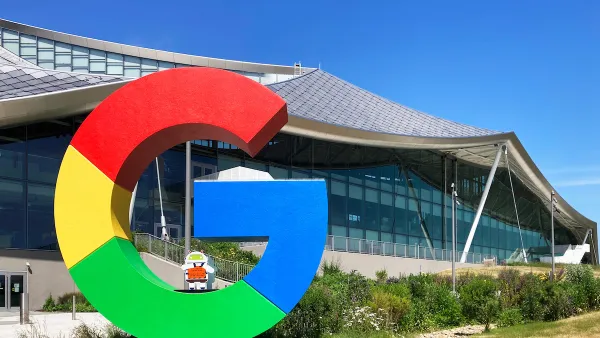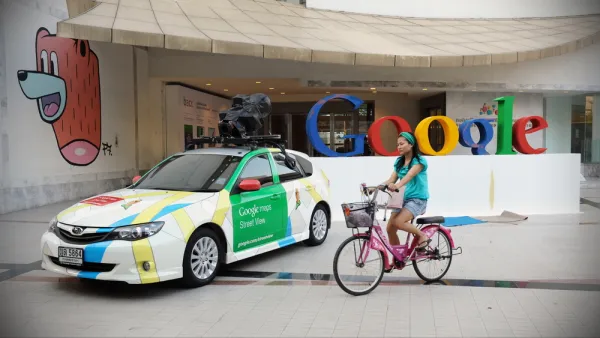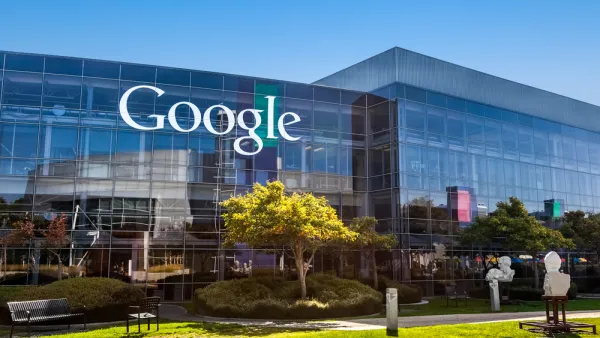There are intercity Google buses, Google ferries, and now, a Google bike plan to connect neighboring Silicon Valley cities to the growing North Bayshore area of Mountain View. Google is offering $5 million to cities to implement the plan.
"Getting to and from North Bayshore is not exactly pleasant," says Shiloh Ballard, executive director of the Silicon Valley Bicycle Coalition about the "mass of low-slung office parks that surrounds Google’s headquarters and is separated from Mountain View proper by Highway 101," as described last month by Conor Dougherty of The New York Times Bits blog.
"Ballard’s group is one of many that have become concerned about how people can bike from the residential areas of Silicon Valley to North Bayshore, where Google, Microsoft, LinkedIn and dozens of other companies are located," writes Nate Berg for Guardian Cities.
"And, since the city of Mountain View recently made available more than 2.2 million square feet of commercial construction rights in North Bayshore, even more people will be heading to the area in the near future," adds Berg, though most of the development rights did not go to Google but to LinkedIn as we noted last month.
In an effort to improve the bicycle commute to North Bayshore, Google set out to rethink the area’s bicycle infrastructure network. Working with the Silicon Valley Bicycle Coalition, the company commissioned an urban planning consultancy, Alta Planning + Design, to look not only at the area immediately surrounding the Googleplex, but at each of the cities in the general vicinity. The goal was to envision a bike network that would help people get from their homes to the tech offices in North Bayshore, but also for the entire community to have better bike access.
The plan [PDF], written by Christopher Kidd, has high aspirations, devoting a section to "Our Vision: North County-as-Copenhagen" (see page 24), though Berg suggests it "may be more vision than plan."
Google’s vision focuses on expanding the existing bicycle infrastructure in the area and targeting what it calls “high-stress streets” – streets where speed limits are 35 miles per hour or more. By adding strategic infrastructure like protected cycle tracks, multi-use paths and buffered bike lanes, the plan envisions a low-stress bike system that covers 277 miles of roadway in the area, up from 87 miles today.
And perhaps the most important part of the plan is that Google is proposing $5 million "in matching grants to cities or other groups in the region who come up with the best ways to start building this system."
Ballard's group and the Santa Clara Valley Transportation Authority will pick the grant winners, according to Sarah Goodyear of CityLab. She adds that the $5 million is "contingent on the approval of Google’s plans by the Mountain View city council."
FULL STORY: Will Google's $5m plan make cycling in the rest of Silicon Valley easier?

National Parks Layoffs Will Cause Communities to Lose Billions
Thousands of essential park workers were laid off this week, just before the busy spring break season.

Retro-silient?: America’s First “Eco-burb,” The Woodlands Turns 50
A master-planned community north of Houston offers lessons on green infrastructure and resilient design, but falls short of its founder’s lofty affordability and walkability goals.

Delivering for America Plan Will Downgrade Mail Service in at Least 49.5 Percent of Zip Codes
Republican and Democrat lawmakers criticize the plan for its disproportionate negative impact on rural communities.

Test News Post 1
This is a summary

Test News Headline 46
Test for the image on the front page.

Balancing Bombs and Butterflies: How the National Guard Protects a Rare Species
The National Guard at Fort Indiantown Gap uses GIS technology and land management strategies to balance military training with conservation efforts, ensuring the survival of the rare eastern regal fritillary butterfly.
Urban Design for Planners 1: Software Tools
This six-course series explores essential urban design concepts using open source software and equips planners with the tools they need to participate fully in the urban design process.
Planning for Universal Design
Learn the tools for implementing Universal Design in planning regulations.
EMC Planning Group, Inc.
Planetizen
Planetizen
Mpact (formerly Rail~Volution)
Great Falls Development Authority, Inc.
HUDs Office of Policy Development and Research
NYU Wagner Graduate School of Public Service





























